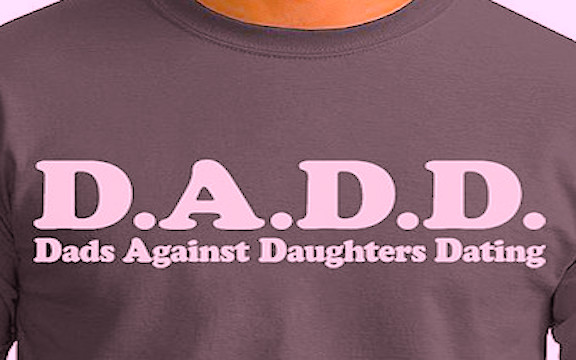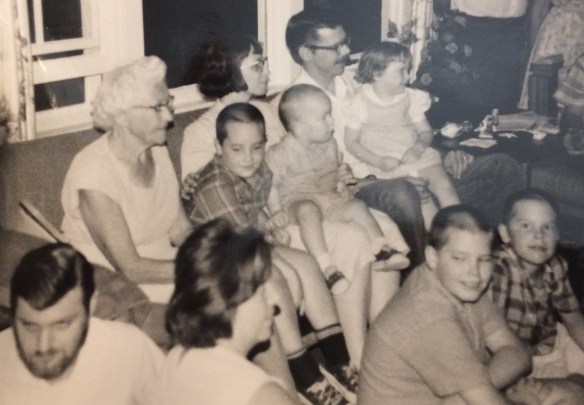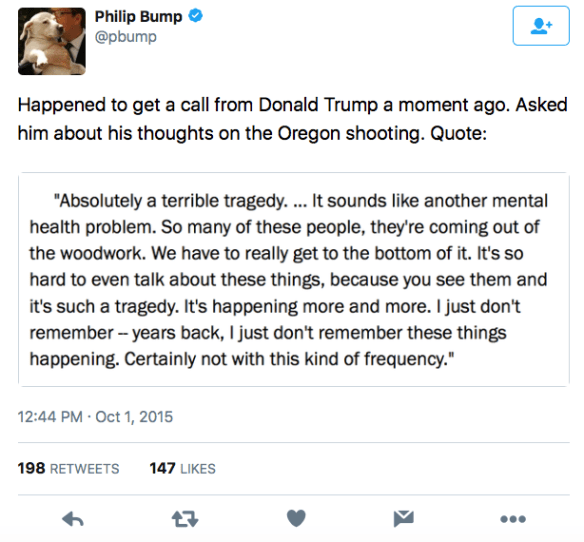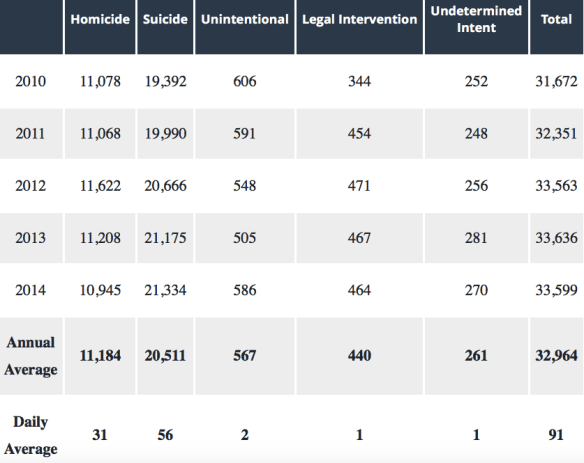by
JC Schildbach, LMHC
(Once again, with all apologies for the overly hetero-normative tone of the piece).
Shopping for Father’s Day gifts can be hard.
A lot of dads will say they don’t want or need anything. Or if they do want something, it’s probably very specific to their particular tastes.
That’s at least in part why the buy-dad-an-unwanted-tie jokes have gone on year after year.
And speaking of jokes, one of the most enduring Father’s Day gifts is the joke T-shirt—or, rather, the T-shirt with the dad-related joke on it. You know the ones—touting dad’s love for beer, or naps, or fishing, or farting.
And those are all perfectly fine, I suppose.
But one gift you don’t want to get your father this year, or any time, is the “D.A.D.D.: Dads Against Daughter’s Dating” T-shirt. The T-shirt exists in many forms, and is available from Internet T-shirt sites and Etsy shops, all the way to the Father’s Day gift displays of department stores.
Many of said T-shirts simply have the main phrase, like this one:

For bland dads who want to make a sexist statement.
But the full joke involves a follow up line of “Shoot the first one and the word will spread” or a similarly-worded joke about shooting any boy who asks a girl out, like this shirt, here:

For dads who feel the need to aggressively advertise their insecurities.
I’ve written before about the whole cultural insistence on threatening boys with violence because of their interest in girls, even when that interest is totally age-appropriate. I don’t understand what such threats are supposed to accomplish, or why such jokes are supposed to be funny.
Most of the responses to questions about the alleged humor of such jokes involve adult men saying that they know what they were like themselves when they were teenagers, and so they know they need to set young men straight/keep them in line.
But I’m not sure if they are thinking clearly about what they are saying.
Are they saying that they needed an adult male to threaten violence against them (or their teenage selves) in order to keep them from raping a girl who agreed to go out on a date with them?
Or perhaps it’s that, as teenagers, they went on dates that ultimately led to kissing, or groping, or any of a number of acts all the way up to and including full-blown intercourse, because their dates were agreeable to engaging in such acts with them—and somehow they think that the best way to prevent their own daughters from being like the girls that they dated is to threaten any teenager who dates their daughters.
But that explanation spawns a whole host of other questions. Did those men, as teenagers and into adult life, really hate the girls they dated in high school so much that they live in fear of their own daughters behaving like those girls? And, if those men did, as teenagers, go out with any of ‘those girls’ (the kind who would engage in at least some form of sexual activity), did threats of violence really shut the men (then boys) down or get them to abstain from sex when it was being offered consensually?
Of course, there is the rather unpleasant possibility that those men are announcing that, as teenagers, they really did engage in sexual assault, and they believe that it was the responsibility of adult males—or more specifically, the fathers of their dates—to stop them from such behavior.
I’m guessing that if someone needs to be a tough-guy dad, threatening one’s daughter’s dates (who happen to be someone else’s children) with physical violence, all because of how one remembers one’s own teenage years, there are a lot of unresolved issues there. And perhaps those issues are manifesting themselves in a need to try and control one’s own daughters—and more specifically one’s own daughters’ sexual behavior, or their potential for sexual behavior. It’s essentially staking a claim to, and asserting a property right over, a teenage girl’s body.
At base, it is an assertion that girls and women are the property of men—first their fathers, and then their husbands. One implication of the anti-dating sentiment is that girls and women should skip dating altogether, and swear off interactions with boys and men, especially sex, until they are married. Essentially, it’s suggesting that there should be a title transfer of the female body/person from dad to husband.
In addition, it is an assertion that all teenage boys are in the throes of raging hormones to the point where they cannot control themselves—or at least not without the threat of violence and death to keep them in check. This, of course, is the kind of “boys will be boys” garbage that both encourages and excuses insufferably sexist behavior, up to and including sexual assault. It is the idea that the behavior of boys and men necessarily involves violence of all sorts.
It is also a kind of challenge to teenage boys—prove you’re a man by persuading a girl to go to bed with you, while dodging the violent father who wants to put a stop to it. In other words, it’s macho crap that perpetuates notions of who is responsible for their behavior, who is not, and how people need to be controlled. It posits the idea that boys are supposed to want sex, and take it when they can, but that girls are not, and are supposed to resist it until it is forced upon them. It promotes the idea of relationships as conquest—at least for males.
If you deny the inherent sexism, stupidity, and outright creepiness of the joke, then why aren’t there T-shirts promoting the idea that boys shouldn’t be allowed to date?
Where are the D.A.S.D. (Dad’s Against Son’s Dating) shirts? Or perhaps the M.A.S.D. (Mother’s Against Sons Dating) shirts? Or even the M.A.D.D. (Mother’s Against Daughters Dating) shirts? Although that last acronym is taken (which could spawn a whole other piece of commentary about why anybody is deliberately “spoofing” Mother’s Against Drunk Driving).
Why not shirts with “M.A. I.S. G.O.D.: Mother’s Against Innocent Sons Going Out on Dates”?
Maybe it’s just that the M.A.S.D. and D.A.S.D. shirts don’t have a very catchy acronym—although I suppose you could make them into D.A.D.S. and M.A.D.S shirts—except that the phrasing gets problematic. I mean, we don’t really want Dads or Moms to be “for” dating sons—especially if the implication of the D.A.D.S. and M.A.D.S. shirts would be that parents are standing up against dating their own daughters and sons. Oh–but wait—there is that whole creepy Daddy-Daughter Date Night thing out there, isn’t there?
I guess when parents get overly obsessed with controlling the sexual behavior of their teenage offspring, things just automatically get creepy.
Overall, rather than getting into these stupid threats of violence, and assertions of rights over the bodies of others, why not, instead, teach all of our kids how to be empathetic, and respectful to themselves and others, when it comes to matters of physicality and sexuality? Why not teach them, both boys and girls, how to avoid succumbing to feelings of peer pressure, or partner pressure, to engage in sex when they are not ready? Why not teach them basic, factual sex education, starting from an early age, so that they will not view sex as some weird mystery, some taboo subject, something that cannot be approached because of the threat of violence, or of damnation, for such approach?
You can teach children and teens the real risks of sexual activity—whether those risks are physical or emotional–without making the main threat one of pointless aggression. And you can teach them how to reduce (not completely eliminate) the potential for unwanted physical or emotional consequences, without having to promote the idea that those people dating daughters should live under threat of violence for wanting to date, or even for having sexual feelings.
Or, perhaps we can keep making obnoxious jokes and T-shirts promoting the idea that daughters’ “purity” needs to be owned and protected by fathers, to the point where threats of violence and murder against other people’s children seem totally appropriate.
In line with those stereotypes and attitudes, how about some of the following, somewhat tortured, acronyms as T-shirts:
D.I.P.C.H.I.T. Dad’s Instigating Pissing Contests w/ Horny Impulsive Teenagers
W.T.F. D.A.D.? Why The Fascination w/ Denying Autonomy for Daughters?
D.O.D.G.E. Dad’s Obsessed w/ Daughter’s Genitals—Eww!
I. A.M. O.C.T.O.P.U.S. Insecure Adult Males Obsessed w/ Controlling Their Offspring’s Puberty Und Sexuality
I’m sure you all can come up with some acronyms that might work with the idea above.
Or maybe we can just shorten that original acronym to what it really means, and think about better ways to deal with it:
D.A.D. Dad’s Afraid of Daughters
Happy Father’s Day!









